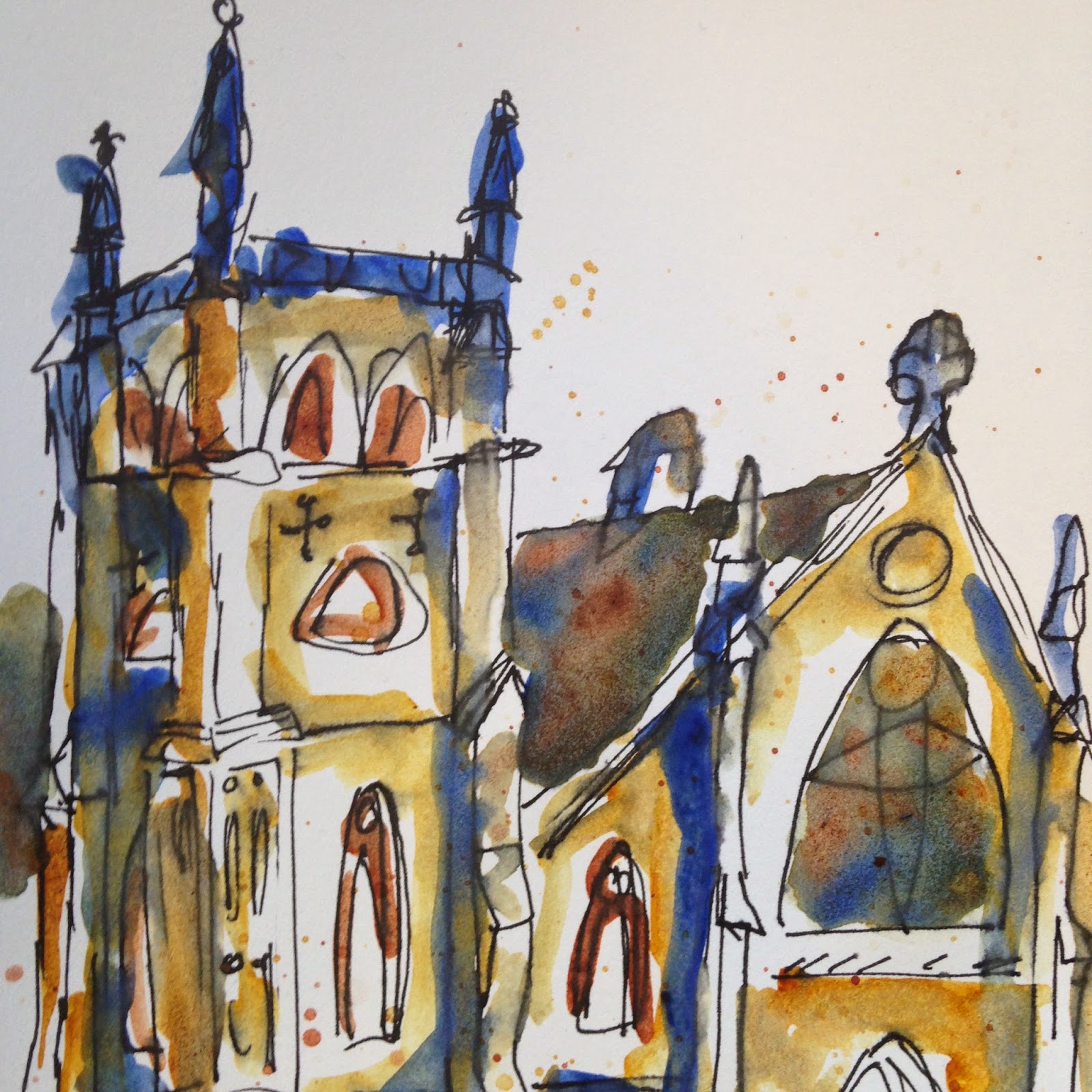Wait, what?
That's right, I said to ruin your watercolor sketch.
In my opinion there is no other sketching experience to compare with
the horror of watching your lines unintentionally smear.
I vividly remember the horror of the first time I put watercolor paints
on a sketch in water-based ink. The sketch was in a Moleskine pocket
watercolor notebook and I'd spent about an hour placing the fountain,
shadows, and luscious leaf canopy. The green I was adding for the copper
fountain smeared with purple from the black ink. I'm pretty confident
that I threw away the pen I used that day.
But following last week's tip and looking through my old sketchbooks I realized that I really liked my "ruined" sketch! Well, at least part of it.
Frustration with my disappointed ideal had kept me from exploring the potential of water-based inks in watercolor sketches. So I invite you to join me as I begin exploring intentionally challenging my ideal of hard lines.
 |
| Statue from the Field Museum on Stillman & Birn Zeta in water-based ink |
Last week I tried two methods to help me play with this technique.
1. Add watercolors (or water) to a sketch you aren't happy with or didn't finish – regardless of ink!
I took some watercolor to an unfinished sketch from our outing to the Field Museum. I'd begun a sketch of a statue but lost perspective and stopped. Normally I'm happy to splash on color and see how things take shape, but I'd done this sketch with an ink I knew was not water resistant.
I added watercolor any way.
The water didn't suddenly fix all the problems with my sketch, but it did change it. As my lines smeared I realized water on water-based inks was a whole new technique I hadn't considered.
2. Test the variations of water resistance in your favorite sketching pens
This week I sketched the same building with three different pens, just to see. I used blank note cards from Paper Source. They are inexpensive and hold watercolor fairly well considering they aren't watercolor paper. That means they are just about perfect for sketching in my opinion!
 |
| Building sketch on Paper Source blank note cards in (L – R): Micron .5 , Uniball, and Sheaffer Skrip ink in a Lamy EF nib |
Here are the pens I used from left to right:
A. Micron .05: Generally when I sketch around the city I use a Micron .05–.005. I like the level of detail it allows for and it dries quickly without the risk of smearing – by hand or water! Some folks find the smaller tips too scratchy to enjoy. I like the way my .005 occasionally skips to give me some line variance.
B. Uniball micro roller ball: These pens were the first ones I ever saw suggested on a sketching blog. They are advertised as having fraud protection ink (for checks). In theory they are water resistant, but depending on the paper I've found they will sometimes smear. Also, these skip badly regardless of the paper. I love their line, but they skip too much for me to use all the time.
C. Lamy Safari (EF nib): I used a rich black ink I inherited from an older relative in this pen. Shaeffer Skrip black ink (date unknown) to be precise. It flows without skipping from the EF nib, but it takes a long time to dry, and if it once had water-resistant properties they have not stood the test of time.
 |
| Sketches with watercolor |
However I was surprised at what a difference the moveable ink made when I was blending colors on the paper! The undertones in the ink made a marked difference. In some places this blending had a muddying effect. In other places it seemed that the ink colors added to the pigment of my paints.
 |
| Detail from above, right. |
You know what else I discovered?
I liked the painting with the smeared lines best! What I had thought would ruin my sketch turned out to be a technique I want to continue using.
Do you ever intentionally mix "un-mixable" elements in your sketches? How do you feel about intentionally ruining your sketches? What makes a "ruined" sketch for you?

Great post! Often these intentional moves and unintentional surprises add such life and energy to a sketch. A ruined sketch for me is one where I didn't stop in time. Knowing when a sketch is complete is sometimes hard... but that's another post!
ReplyDeleteI look forward to your future post on how to know when to stop!
DeleteI seldom make the time to fully explore a sketch. Your suggestions are valuable.
ReplyDeleteI hope these help you find a new "angle" on sketching!
DeleteReally appreciate this post as I often smear an ink or watercolor and declare the sketch ruined. Sometimes when I look back on the sketch, I see the smear actually added interest to the sketch.
ReplyDeleteI'm glad to hear I'm not the only one who struggles with accepting the smear. I look forward to seeing interesting smears in you sketches!
Delete